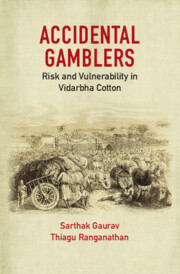1 - A Brief History of Vidarbha
Published online by Cambridge University Press: 18 April 2023
Summary
Vidarbha is a major cotton-growing region in central India. On the political map of India, it is located in the eastern part of the state of Maharashtra, the richest state in India in terms of gross state domestic product and home to the country's financial and commercial capital—Mumbai. It has been a frontier, not only geographically and culturally but also in terms of recasting the global system of cotton growing and manufacturing since the second half of the nineteenth century. It is however a land of several contradictions.
First, despite being home to the winter capital of the state, Nagpur, there has been long-standing demand for separate statehood on grounds of political negligence resulting in significant developmental backlogs. Ethos of being separate from rest of the state are also reflected in the arena of cricket as Vidarbha has one of the three first-class cricket teams in the state, the other two being Mumbai and Maharashtra. Second, it is one of the most mineral-rich regions in the country and contributes to over two-thirds of mineral deposits of the state and most of its forest resources. Yet, as if there were a ‘resource curse’, it is one of the most backward regions. Third, far from the popular imagination of Vidarbha as a homogenous region, it is an amalgamation of two administrative divisions having distinct linguistic and sociocultural histories. Whilst the Amravati division (western part) has a shared history with the erstwhile Berar Province, the Nagpur division (eastern part) has a shared history with what comprised districts of the Central Provinces during colonial era. The cotton tracts of the former have primarily been the epicentre of agrarian distress and witnessed a spate of farmers’ suicides over the past two and a half decades whereas the densely forested areas of the latter are afflicted with Naxalite–Maoist insurgency. In fact, the parts of eastern Vidarbha that have been witnessing Naxal extremism for over half a century continue to have meaning in the political assertion of Gonds as erstwhile rulers of the kingdom of Nagpur, but they are conspicuous by their absence in the agricultural development discourse on Vidarbha that is primarily concentrated on western Vidarbha. Fourth, it became a prominent centre of Buddhism, but it has witnessed centuries of bloody power struggles that shaped the history of India.
- Type
- Chapter
- Information
- Accidental GamblersRisk and Vulnerability in Vidarbha Cotton, pp. 13 - 59Publisher: Cambridge University PressPrint publication year: 2023



